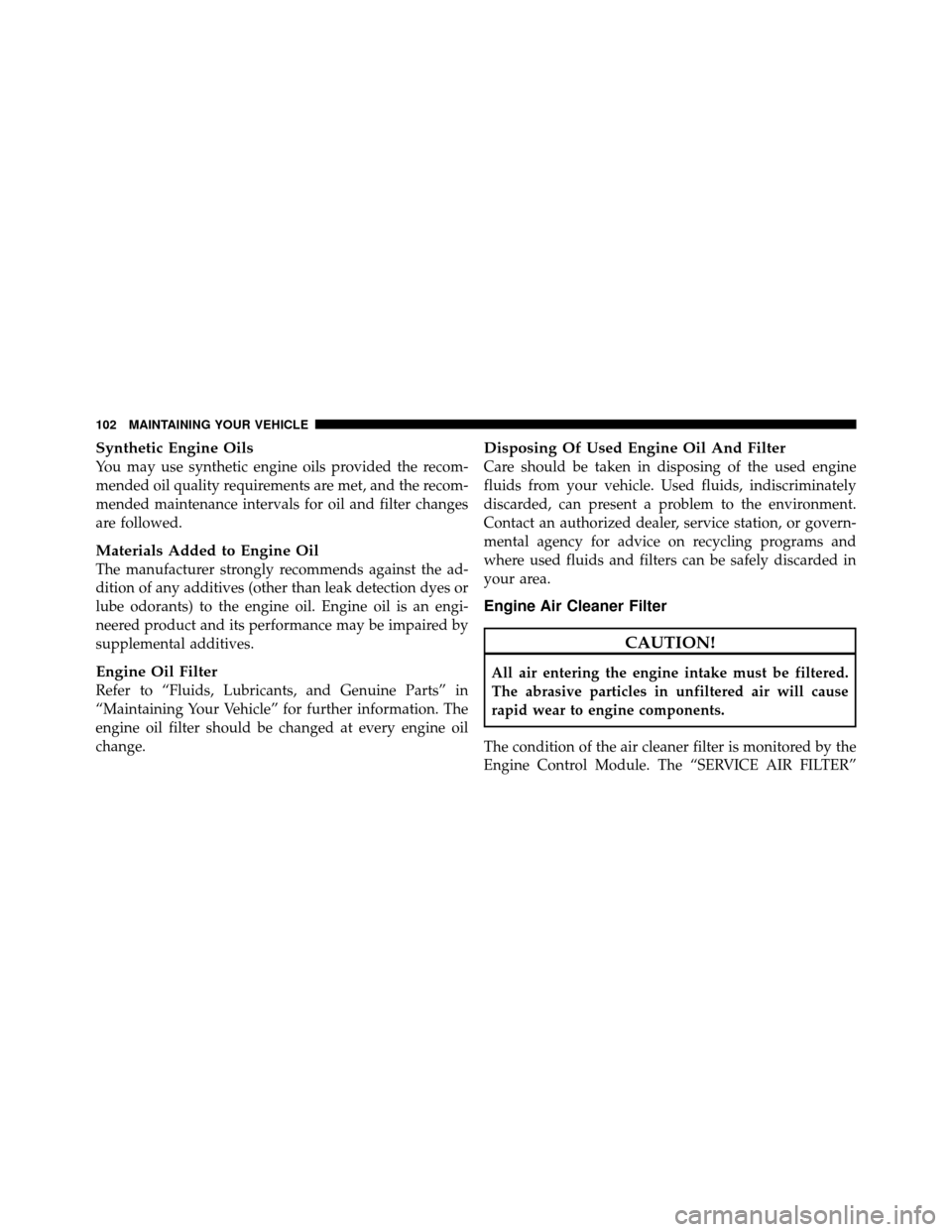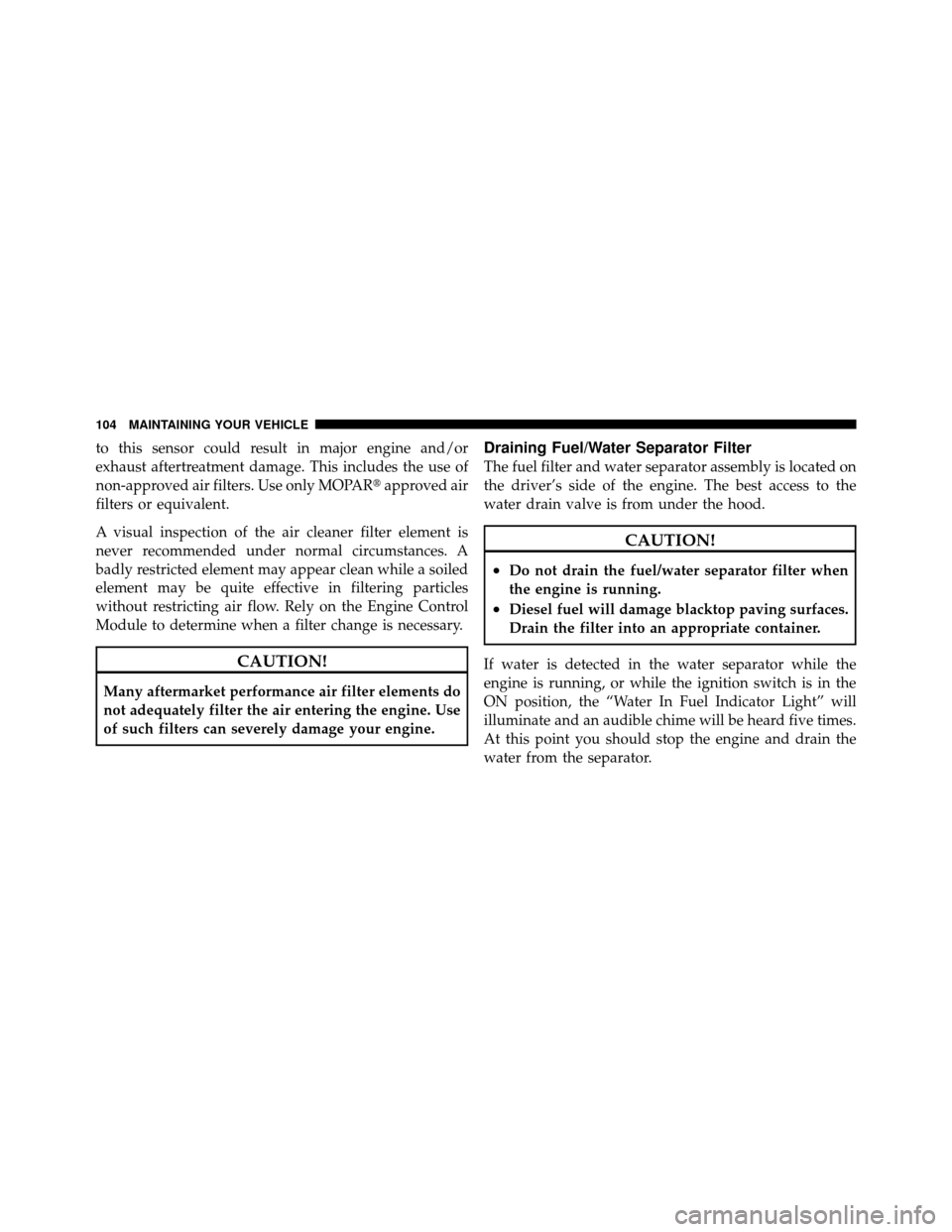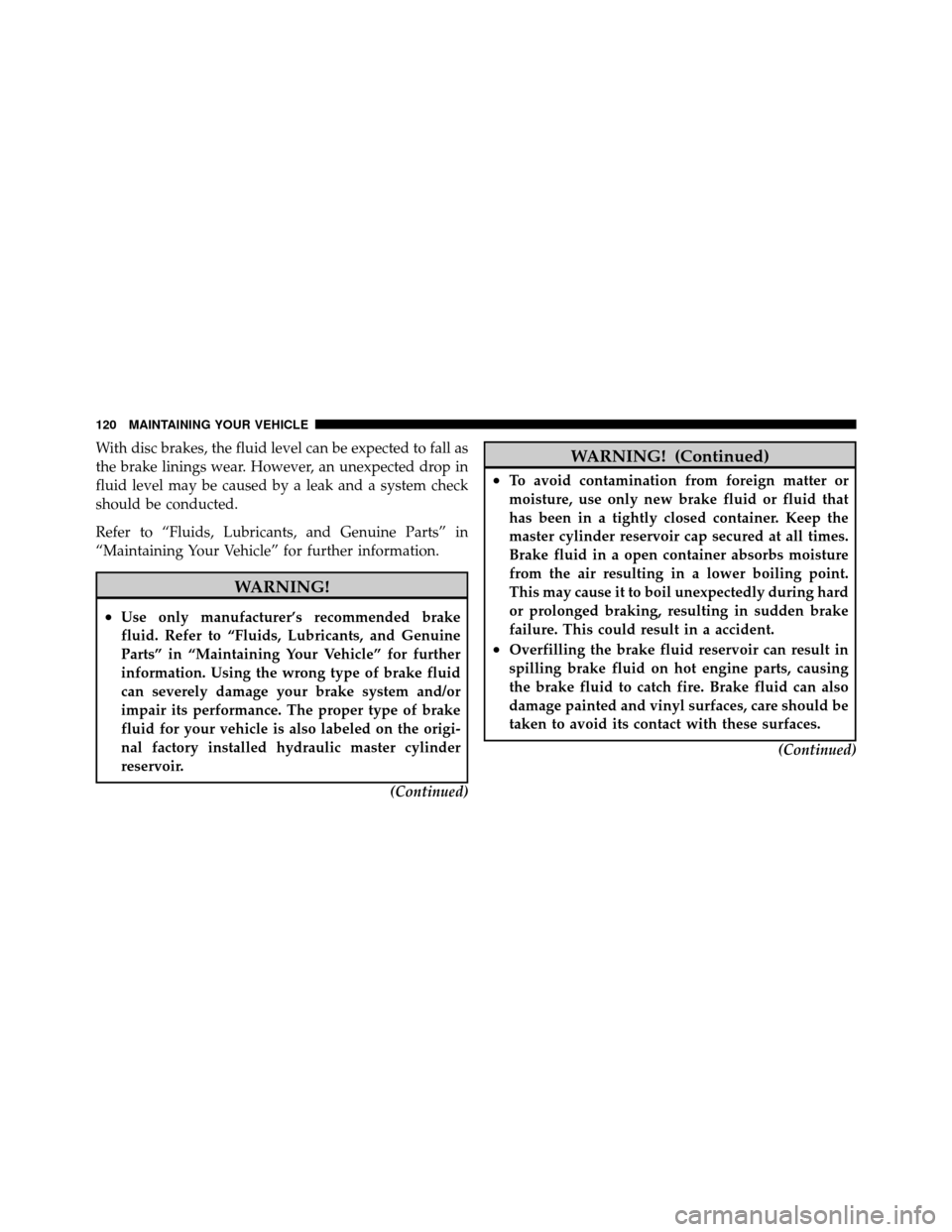Page 102 of 170
In ambient temperatures below 0°F (-18°C), SAE 5W-40
syntheticengine oil that meets Chrysler Materials Stan-
dard MS-10902 and the API CJ-4 engine oil category is
required.
CAUTION!
Failure to use SAE 5W-40 synthetic engine oil in
ambient temperatures below 0°F (-18°C) could result
in severe engine damage.
Engine oil not designated by the Chrysler or Cummins�
Material Standards and API CJ-4 should not be used, as
engine and exhaust system durability may be compro-
mised. The engine oil filler cap also shows the recom-
mended engine oil viscosity for your engine. For infor-
mation on engine oil filler cap location, refer to “Engine
Compartment” in “Maintaining Your Vehicle” for further
information.
6
MAINTAINING YOUR VEHICLE 101
Page 103 of 170

Synthetic Engine Oils
You may use synthetic engine oils provided the recom-
mended oil quality requirements are met, and the recom-
mended maintenance intervals for oil and filter changes
are followed.
Materials Added to Engine Oil
The manufacturer strongly recommends against the ad-
dition of any additives (other than leak detection dyes or
lube odorants) to the engine oil. Engine oil is an engi-
neered product and its performance may be impaired by
supplemental additives.
Engine Oil Filter
Refer to “Fluids, Lubricants, and Genuine Parts” in
“Maintaining Your Vehicle” for further information. The
engine oil filter should be changed at every engine oil
change.
Disposing Of Used Engine Oil And Filter
Care should be taken in disposing of the used engine
fluids from your vehicle. Used fluids, indiscriminately
discarded, can present a problem to the environment.
Contact an authorized dealer, service station, or govern-
mental agency for advice on recycling programs and
where used fluids and filters can be safely discarded in
your area.
Engine Air Cleaner Filter
CAUTION!
All air entering the engine intake must be filtered.
The abrasive particles in unfiltered air will cause
rapid wear to engine components.
The condition of the air cleaner filter is monitored by the
Engine Control Module. The “SERVICE AIR FILTER”
102 MAINTAINING YOUR VEHICLE
Page 105 of 170

to this sensor could result in major engine and/or
exhaust aftertreatment damage. This includes the use of
non-approved air filters. Use only MOPAR�approved air
filters or equivalent.
A visual inspection of the air cleaner filter element is
never recommended under normal circumstances. A
badly restricted element may appear clean while a soiled
element may be quite effective in filtering particles
without restricting air flow. Rely on the Engine Control
Module to determine when a filter change is necessary.
CAUTION!
Many aftermarket performance air filter elements do
not adequately filter the air entering the engine. Use
of such filters can severely damage your engine.
Draining Fuel/Water Separator Filter
The fuel filter and water separator assembly is located on
the driver’s side of the engine. The best access to the
water drain valve is from under the hood.
CAUTION!
•Do not drain the fuel/water separator filter when
the engine is running.
•Diesel fuel will damage blacktop paving surfaces.
Drain the filter into an appropriate container.
If water is detected in the water separator while the
engine is running, or while the ignition switch is in the
ON position, the “Water In Fuel Indicator Light” will
illuminate and an audible chime will be heard five times.
At this point you should stop the engine and drain the
water from the separator.
104 MAINTAINING YOUR VEHICLE
Page 108 of 170

CAUTION! (Continued)
•Do not prefill the fuel filter when installing a new
fuel filter. There is a possibility debris could be
introduced into the fuel filter during this action. It
is best to install the filter dry and allow the in-tank
lift pump to prime the fuel system.
1. Ensure engine is turned off.
2. Place drain pan under the fuel filter drain hose.
3. Open the water drain valve 1/4 turn counterclockwise
and completely drain fuel and water into the approved
container.
4. Close the water drain valve.
5. Remove lid using a socket or strap wrench. Rotate
counterclockwise for removal. Remove used o-ring and
discard it. 6. Remove the used filter cartridge from the housing and
dispose of according to your local regulations.
7. Wipe clean the sealing surfaces of the lid and housing.
8. Install new o-ring back into ring groove on the filter
housing and lubricate with clean engine oil.
9. Remove new filter cartridge from plastic bag and
install into housing.
NOTE:
Do not remove cartridge from bag until you
reach this step in order to keep cartridge clean.
10. Push down on the cartridge to ensure it is properly
seated. Do not pre-fill the filter housing with fuel.
11. Install lid onto housing and tighten to 22.5 ft lbs
(30.5 N.m). Do not overtighten the lid.
12. Prime the engine using the procedure in “Priming If
The Engine Has Run Out Of Fuel.” Then start the engine
and confirm there are no leaks.
6
MAINTAINING YOUR VEHICLE 107
Page 121 of 170

With disc brakes, the fluid level can be expected to fall as
the brake linings wear. However, an unexpected drop in
fluid level may be caused by a leak and a system check
should be conducted.
Refer to “Fluids, Lubricants, and Genuine Parts” in
“Maintaining Your Vehicle” for further information.
WARNING!
•Use only manufacturer’s recommended brake
fluid. Refer to “Fluids, Lubricants, and Genuine
Parts” in “Maintaining Your Vehicle” for further
information. Using the wrong type of brake fluid
can severely damage your brake system and/or
impair its performance. The proper type of brake
fluid for your vehicle is also labeled on the origi-
nal factory installed hydraulic master cylinder
reservoir.(Continued)
WARNING! (Continued)
•To avoid contamination from foreign matter or
moisture, use only new brake fluid or fluid that
has been in a tightly closed container. Keep the
master cylinder reservoir cap secured at all times.
Brake fluid in a open container absorbs moisture
from the air resulting in a lower boiling point.
This may cause it to boil unexpectedly during hard
or prolonged braking, resulting in sudden brake
failure. This could result in a accident.
•Overfilling the brake fluid reservoir can result in
spilling brake fluid on hot engine parts, causing
the brake fluid to catch fire. Brake fluid can also
damage painted and vinyl surfaces, care should be
taken to avoid its contact with these surfaces.(Continued)
120 MAINTAINING YOUR VEHICLE
Page 123 of 170

Automatic Transmission – If Equipped
Lubricant Selection
Refer to “Fluids, Lubricants, and Genuine Parts” in
“Maintaining Your Vehicle” for further information.
Fluid Level Check – 68RFE (Ram Truck Only)
If your vehicle is equipped with a dipstick, use the
following procedure. If your vehicle has a capped dip-
stick tube, it is sealed and should not be tampered with.
Your authorized dealer has the proper tools to ensure that
the fluid level is set properly. The fluid level should be
checked when the engine is fully warmed up and the
fluid in the transmission is at normal operating tempera-
ture. Operation of the transmission with an improper
fluid level will greatly reduce the life of the transmission
and of the fluid. Check the fluid level whenever the
vehicle is serviced.
To properly check the automatic transmission fluid level,
the following procedure must be used:1. Operate the engine at idle speed and normal operating
temperature.
2. The vehicle must be on level ground.
3. Fully apply the parking brake and press the brake
pedal.
4. Place the shift lever momentarily into each gear posi-
tion ending with the shift lever in PARK.
5. Remove the dipstick, wipe it clean and reinsert it until
seated.
6. Remove the dipstick again and note the fluid level on
both sides. The fluid level should be between the “HOT”
(upper) reference holes on the dipstick at normal operat-
ing temperature. Verify that solid coating of oil is seen on
both sides of the dipstick. If the fluid is low, add as
required into the dipstick tube.
Do not overfill.After
adding any quantity of oil through the oil fill tube, wait
a minimum of two minutes for the oil to fully drain into
the transmission before rechecking the fluid level.
122 MAINTAINING YOUR VEHICLE
Page 125 of 170

3. Fully apply the parking brake and press the brake
pedal.
4. Place the shift lever momentarily into each gear posi-
tion ending with the shift lever in PARK. Make sure the
engine is running at idle speed.
5. Remove the dipstick and determine if the fluid is hot
or cold. Hot fluid is approximately 160°F to 175°F (70°C
to 82°C). This is the normal operating temperature after
the vehicle has been driven at least 15 miles (25 km). The
fluid cannot be comfortably held between the fingertips.
Only use the cold region of the dipstick as a rough
reference when doing initial oil level set after transmis-
sion rebuild or transmission refill.
6. Wipe the dipstick clean and reinsert it until seated.
7. Remove the dipstick again and note the fluid level on
both sides. The fluid level should be between the HOT(upper) reference holes on the dipstick at normal operat-
ing temperature. Verify that a solid coating of oil is seen
on both sides of the dipstick. If the fluid is low, add
MOPAR�
AS68RC Automatic Transmission Fluid or
equivalent as required into the dipstick tube. Do not
overfill. Never use any ATF other than MOPAR�
AS68RC Automatic Transmission Fluid or equivalent.
After adding any quantity of oil through the dipstick
tube, wait a minimum of two minutes for the oil to fully
drain into the transmission before rechecking the fluid
level.
NOTE: If it is necessary to check the transmission below
the operating temperature, the fluid level should be
between the two COLD (lower) holes on the dipstick
with the fluid at approximately 70°F to 85°F (20°C to
30°C). If the fluid level is correctly established at room
temperature, it should be between the HOT (upper)
reference holes when the transmission reaches 160°F to
175°F (70°C to 82°C).
124 MAINTAINING YOUR VEHICLE
Page 131 of 170
FLUID CAPACITIES
U.S.Metric
Fuel (Approximate)
2500/3500 Shortbed Models 34 Gallons129 Liters
2500/3500 Longbed Models 35 Gallons132 Liters
Standard Rear Tank – Chassis Cab Only 52 Gallons197 Liters
Optional Midship Tank – Chassis Cab Only 22 Gallons83 Liters
Diesel Exhaust Fluid Tank (Approximate) – Chassis
Cab Only 8 Gallons
30 Liters
Engine Oil with Filter
6.7L Turbo Diesel Engine 12 Quarts11.4 Liters
Cooling System
6.7L Turbo Diesel Engine (MOPAR� Engine Coolant/
Antifreeze 5 Year/100,000 Mile Formula or equivalent) 5.7 Gallons
21.4 Liters
130 MAINTAINING YOUR VEHICLE